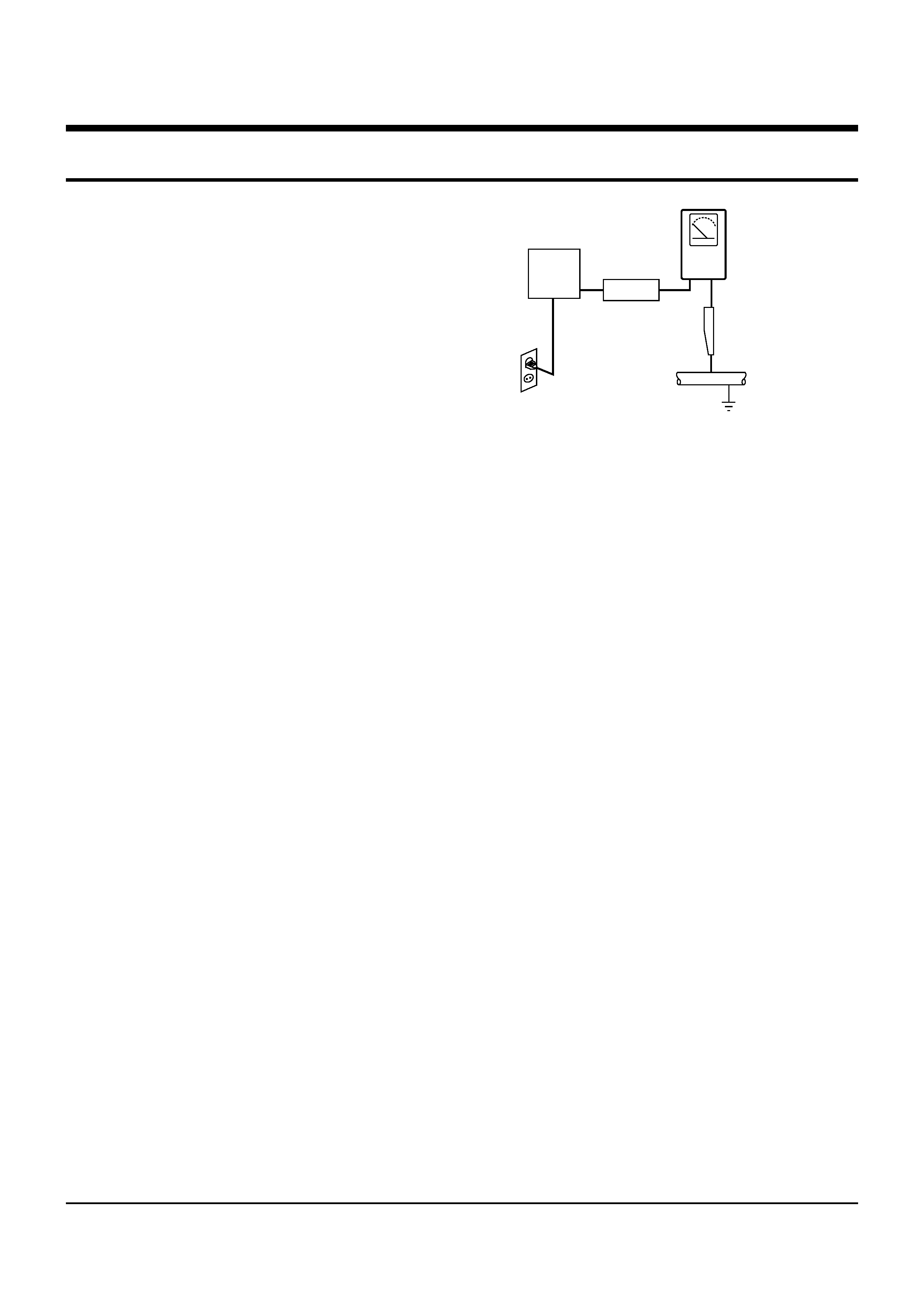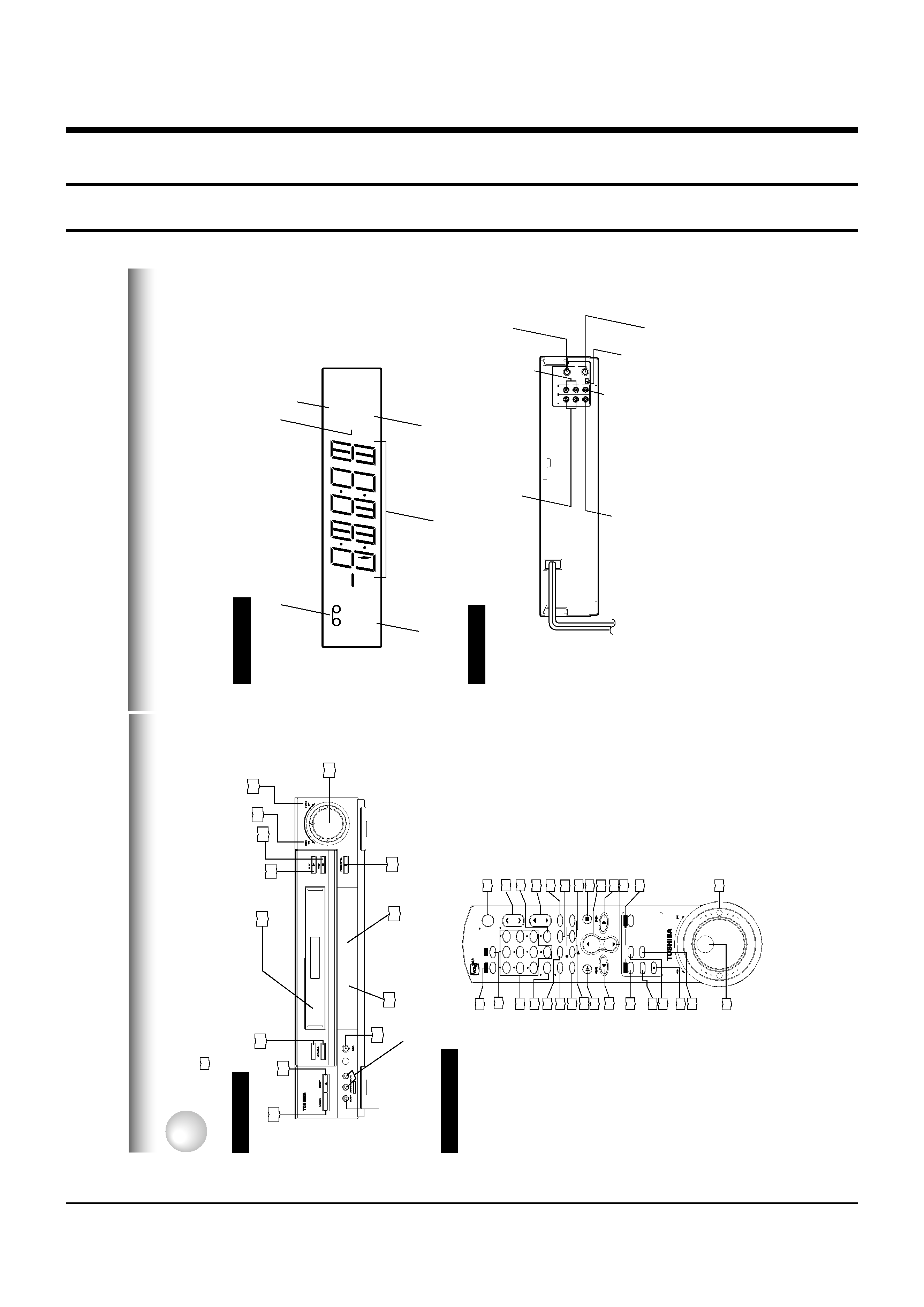
SERVICE MANUAL
FILE NO. 120-200173
VIDEO CASSETTE RECORDER
W-715C
JUN, 2001
W-715C
7/21/01
12:18 PM
Page 1

TOTAL CONTENTS
1. Precautions
2. Reference Information
3. Product Specifications
4. Disassembly and Reassembly
5. Alignment and Adjustment
6. Exploded View
7. Replacement Parts List
8. Block Diagram
9. PCB Diagrams
10. Schematic Diagrams

Toshiba
1-1
1. Precautions
1. Be sure that all of the built-in protective devices are
replaced. Restore any missing protective shields.
2. When reinstalling the chassis and its assemblies, be
sure to restore all pretective devices, including :
control knobs and compartment covers.
3. Make sure that there are no cabinet openings
through which people--particularly children
--might insert fingers and contact dangerous
voltages. Such openings include the spacing
between the picture tube and the cabinet mask,
excessively wide cabinet ventilation slots, and
improperly fitted back covers.
If the measured resistance is less than 1.0 megohm
or greater than 5.2 megohms, an abnormality exists
that must be corrected before the unit is returned
to the customer.
4. Leakage Current Hot Check (See Fig. 1-1) :
Warning : Do not use an isolation transformer
during this test. Use a leakage current tester or a
metering system that complies with American
National Standards Institute (ANSI C101.1,
Leakage Current for Appliances), and Underwriters
Laboratories (UL Publication UL1410, 59.7).
5. With the unit completely reassembled, plug the AC
line cord directly the power outlet. With the unit's
AC switch first in the ON position and then OFF,
measure the current between a known erath
ground (metal water pipe, conduit, etc.) and all
exposed metal parts, including : antennas, handle
brackets, metal cabinets, screwheads and control
shafts. The current measured should not exceed
0.5 milliamp. Reverse the power-plug prongs in the
AC outlet and repeat the test.
6. X-ray Limits :
The picture tube is designed to prohibit X-ray
emissions. To ensure continued X-ray protection,
replace the picture tube only with one that is the
same type as the original.
Fig. 1-1 AC Leakage Test
7. Antenna Cold Check :
With the unit's AC plug disconnected from the
AC source, connect an electrical jumper across the
two AC prongs. Connect one lead of the ohmmeter
to an AC prong.
Connect the other lead to the coaxial connector.
8. High Voltage Limit :
High voltage must be measured each time
servicing is done on the B+, horizontal deflection
or high voltage circuits.
Heed the high voltage limits. These include the
X-ray protection Specifications Label, and the
Product Safety and X-ray Warning Note on the
service data schematic.
9. Some semiconductor ("solid state") devices are
easily damaged by static electricity.
Such components are called Electrostatically
Sensitive Devices (ESDs); examples include
integrated circuits and some field-effect transistors.
The following techniques will reduce the
occurrence of component damage caused by static
electricity.
10. Immediately before handling any semiconductor
components or assemblies, drain the electrostatic
charge from your body by touching a known
earth ground. Alternatively, wear a discharging
Wrist-strap device. (Be sure to remove it prior to
applying power--this is an electric shock
precaution.)
DEVICE
UNDER
TEST
(READING SHOULD
NOT BE ABOVE
0.5mA)
LEAKAGE
CURRENT
TESTER
EARTH
GROUND
TEST ALL
EXPOSED METER
SURFACES
ALSO TEST WITH
PLUG REVERSED
(USING AC ADAPTER
PLUG AS REQUIRED)
2-WIRE CORD

Precautions
1-2
Toshiba
11. High voltage is maintained within specified limits
by close-tolerance, safety-related components and
adjustments. If the high voltage exceeds the
specified limits, check each of the special
components.
12. Design Alteration Warning :
Never alter or add to the mechanical or electrical
design of this unit. Example : Do not add
auxiliary audio or video connectors.
Such alterations might create a safety hazard.
Also, any design changes or additions will void
the manufacturer's warranty.
13. Hot Chassis Warning :
Some TV receiver chassis are electrically
connected directly to one conductor of the AC
power cord. If an isolation transformer is not
used, these units may be safely serviced only if
the AC power plug is inserted so that the chassis
is connected to the ground side of the AC source.
To confirm that the AC power plug is inserted
correctly, do the following : Using an AC
voltmeter, measure the voltage between the
chassis and a known earth ground. If the reading
is greater than 1.0V, remove the AC power plug,
reverse its polarity and reinsert. Re-measure the
voltage between the chassis and ground.
14. Some TV chassis are designed to operate with 85
volts AC between chassis and ground, regardless
of the AC plug polarity. These units can be safely
serviced only if an isolation transformer inserted
between the receiver and the power source.
15. Never defeat any of the B+ voltage interlocks.
Do not apply AC power to the unit (or any of its
assemblies) unless all solid-state heat sinks are
correctly installed.
16. Always connect a test instrument's ground lead to
the instrument chassis ground before connecting
the positive lead; always remove the instrument's
ground lead last.
17. Observe the original lead dress, especially near
the following areas : Antenna wiring, sharp
edges, and especially the AC and high voltage
power supplies. Always inspect for pinched, out-
of-place, or frayed wiring. Do not change the
spacing between components and the printed
circuit board. Check the AC power cord for
damage. Make sure that leads and components
do not touch thermally hot parts.
18. Picture Tube Implosion Warning :
The picture tube in this receiver employs
"integral implosion" protection. To ensure
continued implosion protection, make sure that
the replacement picture tube is the same as the
original.
19. Do not remove, install or handle the picture tube
without first putting on shatterproof goggles
equipped with side shields. Never handle the
picture tube by its neck. Some "in-line" picture
tubes are equipped with a permanently attached
deflection yoke; do not try to remove such
"permanently attached" yokes from the picture
tube.
20. Product Safety Notice :
Some electrical and mechanical parts have special
safety-related characteristics which might not be
obvious from visual inspection. These safety
features and the protection they give might be
lost if the replacement component differs from the
original--even if the replacement is rated for
higher voltage, wattage, etc.
Components that are critical for safety are
indicated in the circuit diagram by shading,
(
or
).
Use replacement components that have the same
ratings, especially for flame resistance and
dielectric strength specifications. A replacement
part that does not have the same safety
characteristics as the original might create shock,
fire or other hazards.

Toshiba
2-1
9
Hi-Fi
SAP
VCR
TIMER
Rear
Panel
LINE
IN
1
AUDIO
(Rear),
2
(Front)
jacks
If
the
connected
equipment
is
monaural
(has
one
audio
output
jack),
connect
the
L
(MONO)
side,
the
same
sound
is
recorded
on
both
L
and
R
on
the
Hi-Fi
track.
Multifunctional
indicator
VCR
indicator
Cassette
indicator
Timer
recording
indicator
Hi-Fi
indicator
SAP
indicator
VCR
Display
INTRODUCTION
L
R
CH
selector
(3/4)
LINE
OUT
AUDIO
jacks
(L,
R)
LINE
OUT
VIDEO
jack
RF
IN
(FROM
ANT.)
terminal
LINE
IN
1
AUDIO
jacks
(L,
R)
RF
OUT
(TO
TV)
terminal
LINE
IN
1
VIDEO
jack
CH
OUT (TO
TV)
IN
(FROM
ANT.)
LINE
OUT
LINE
IN
1
VIDEO
AUDIO
34
RF
To
wall
outlet
8
24
10
9
18
19
19
14
18
20
19
19
24
LINE
IN
2
20
TV
VCR
PROG.
ENTER
TV/
VCR
POWER
CH/TRK
TV
VOL
I.SELECT
REMAIN/
COUNTER
DISPLA
Y
COUNT
RESET
SP/
SLP
REC
TIMER
SLOW
PLA
Y/x2
PAUSE
/STILL
REW
F
F
CURSOR
ST
OP
1
2
3
456
7
8
9
CANCEL
A.SELECT
EJECT
VC-715
0
10
0
VCR
14
TV
Number
buttons
24
I.
SELECT
24
SP/SLP
24
DISPLAY
22
21
SLOW
19
REW
*
14
PROG.
18
EJECT
20
PAUSE/STILL
19
FF
*
19
STOP
*
14
ENTER
19
PLAY/x2
*
26
TIMER
REC
24
22
COUNT
RESE
T
24
TV/VCR
33
TV
VOL
17
100
19
CH/TRK
14
REMAIN/COUNTER
22
A.SELECT
32
CANCEL
27
SHUTTLE
DIA
L
VCR
Plus+
VCR
Plus+
30
POWER
20
21
JOG
DIAL
33
Fr
ont
Panel
Remote
Contr
ol
*These
buttons
are
used
to
control
the
cursor
on
the
screen.
INTRODUCTION
Identification
of
Controls
See
the
page
in
for
details.
This
manual
shows
the
names
of
buttons
in
italics.
To
operate
this
VCR.
To
operate
your
TV.
CHANNEL
Remote
Sensor
VCR
Display
STOP
PLAY
FWD
Cassette
compartment
REV
EJECT
POWER
LINE
IN
2
VIDEO
jack
LINE
IN
2
AUDIO
(L/MONO,
R)
jacks
REC
PAUSE/STILL
SHUTTLE
2. Reference Information
2-1 Operation of Controls
